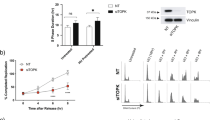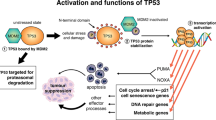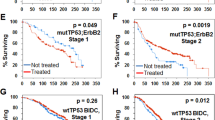Abstract
Loss of p21 in human cancer cells results in checkpoint failure, induction of polyploidy and subsequent apoptosis following DNA damage. Tumours in immunodeficient mice derived from cells lacking p21 are also more sensitive to ionizing radiation than their wild-type counterparts. Abrogation of p53 in the p21+/+ parental cells results in an in vitro phenotype that is indistinguishable from that of the p21 knockout cells. Thus, the in vitro phenotype resulting from loss of p21 is consistent with its well-established role in the p53/p21 damage response pathway. However, despite the similar in vitro phenotype, p21+/+ cells with abrogated p53 show no evidence of the sensitivity observed in the p21−/− cells when grown as tumours in immunodeficient mice. The increased radio-sensitization stabilization of p21−/− tumours is also unrelated to the increase in apoptosis observed in these tumours following radiation treatment. Apoptosis in the p21−/− tumours was significantly reduced by expression of bcl-2 without any corresponding change in the overall response of the tumour. Similarly, abrogation of p53 in the p21+/+ tumours substantially increased radiation-induced apoptosis within the tumours without increasing their radiation sensitivity. Dissociation of these in vivo and in vitro phenotypes indicates that p21 participates in a novel in vivo specific damage response pathway that is distinct from its role in the p53 pathway, and therefore that it may be an effective therapeutic target for cancer therapy.
This is a preview of subscription content, access via your institution
Access options
Subscribe to this journal
Receive 50 print issues and online access
$259.00 per year
only $5.18 per issue
Buy this article
- Purchase on Springer Link
- Instant access to full article PDF
Prices may be subject to local taxes which are calculated during checkout



Similar content being viewed by others
References
Bhatia K, Fan S, Spangler G, Weintraub M, O'Connor PM, Judde JG and Magrath I. . 1995 Cancer Res. 55: 1431–1435.
Biggs JR and Kraft AS. . 1995 J. Mol. Med. 73: 509–514.
Brizel DM, Scully SP, Harrelson JM, Layfield LJ, Bean JM, Prosnitz LR and Dewhirst MW. . 1996 Cancer Res. 56: 941–943.
Brown JM. . 1996 Nat. Med. 2: 1055–1056.
Brown JM and Giaccia AJ. . 1998 Cancer Res. 58: 1408–1416.
Fan S, Chang JK, Smith ML, Duba D, Fornace Jr AJ and O'Connor PM. . 1997 Oncogene 14: 2127–2136.
Fisher DE. . 1994 Cell 78: 539–542.
Gjerset RA and Sobel RE. . 1997 In: Bertino JR. (ed.). Encyclopedia of Cancer. Academic Press: San Diego pp. 1785–1791.
Graeber TG, Osmanian C, Jacks T, Housman DE, Koch CJ, Lowe SW and Giaccia AJ. . 1996 Nature 379: 88–91.
Halbert CL, Demers GW and Galloway DA. . 1992 J. Virol. 66: 2125–2134.
Han JW, Dionne CA, Kedersha NL and Goldmacher VS. . 1997 Cancer Res. 57: 176–182.
Hartwell LH and Kastan MB. . 1994 Science 266: 1821–1828.
Hockel M, Schlenger K, Aral B, Mitze M, Schaffer U and Vaupel P. . 1996 Cancer Res. 56: 4509–4515.
Hockenbery D, Nunez G, Milliman C, Schreiber RD and Korsmeyer SJ. . 1990 Nature 348: 334–336.
Huang H, Li CY and Little JB. . 1996 Int. J. Radiat. Biol. 70: 151–160.
Kyprianou N, King ED, Bradbury D and Rhee JG. . 1997 Int. J. Cancer 70: 341–348.
Lock RB and Stribinskiene L. . 1996 Cancer Res. 56: 4006–4012.
Scheffner M, Huibregtse JM, Vierstra RD and Howley PM. . 1993 Cell 75: 495–505.
Thompson CB. . 1995 Science 267: 1456–1462.
Waldman T, Kinzler KW and Vogelstein B. . 1995 Cancer Res. 55: 5187–5190.
Waldman T, Lengauer C, Kinzler KW and Vogelstein B. . 1996 Nature 381: 713–716.
Waldman T, Zhang Y, Dillehay L, Yu J, Kinzler K, Vogelstein B and Williams J. . 1997 Nat. Med. 3: 1034–1036.
Wang YA, Elson A and Leder P. . 1997 Proc. Natl. Acad. Sci. USA 94: 14590–14595.
Westphal CH, Rowan S, Schmaltz C, Elson A, Fisher DE and Leder P. . 1997 Nat. Genet. 16: 397–401.
Wouters BG, Giaccia AJ, Denko NC and Brown JM. . 1997 Cancer Res. 57: 4703–4706.
Yin DX and Schimke RT. . 1995 Cancer Res. 55: 4922–4928.
Acknowledgements
The excellent technical assistance of Patricia A McAfee, Diane Rapacchietta, and Douglas Menke is greatly acknowledged. This work was supporetd by grants RO1 CA15201 and CA 64489. NC Denko is supported by PHS NRSA training grant CA 09302. BG Wouters is a Research fellow of the National Cancer Institute of Canada supported with funds provided by the Canadian Cancer Society.
Author information
Authors and Affiliations
Rights and permissions
About this article
Cite this article
Wouters, B., Denko, N., Giaccia, A. et al. A p53 and apoptotic independent role for p21waf1 in tumour response to radiation therapy. Oncogene 18, 6540–6545 (1999). https://doi.org/10.1038/sj.onc.1203053
Received:
Revised:
Accepted:
Published:
Issue Date:
DOI: https://doi.org/10.1038/sj.onc.1203053
Keywords
This article is cited by
-
Multiple functions of p21 in cancer radiotherapy
Journal of Cancer Research and Clinical Oncology (2021)
-
Management of locally advanced HPV-related oropharyngeal squamous cell carcinoma: where are we?
European Archives of Oto-Rhino-Laryngology (2016)
-
CDKN1A regulates Langerhans cell survival and promotes Treg cell generation upon exposure to ionizing irradiation
Nature Immunology (2015)
-
p21(WAF1)-mediated transcriptional targeting of inducible nitric oxide synthase gene therapy sensitizes tumours to fractionated radiotherapy
Gene Therapy (2007)
-
The role of apoptosis in cancer development and treatment response
Nature Reviews Cancer (2005)



